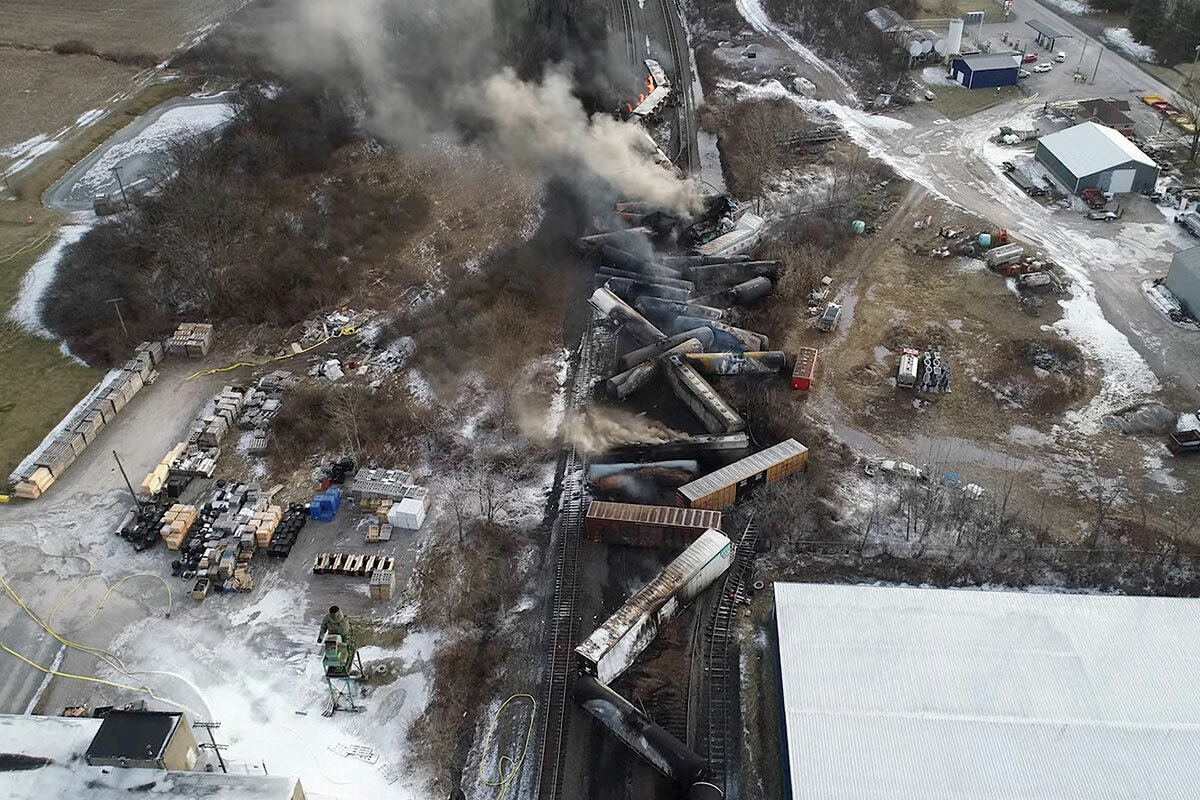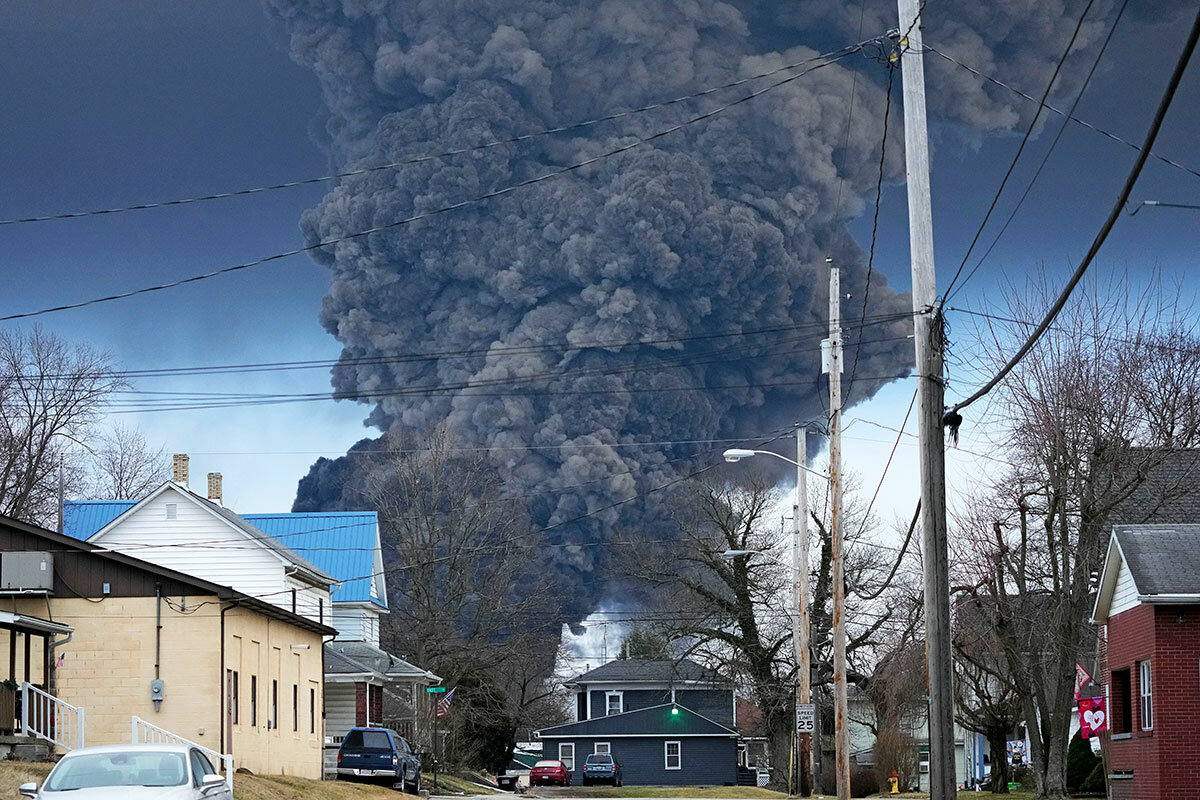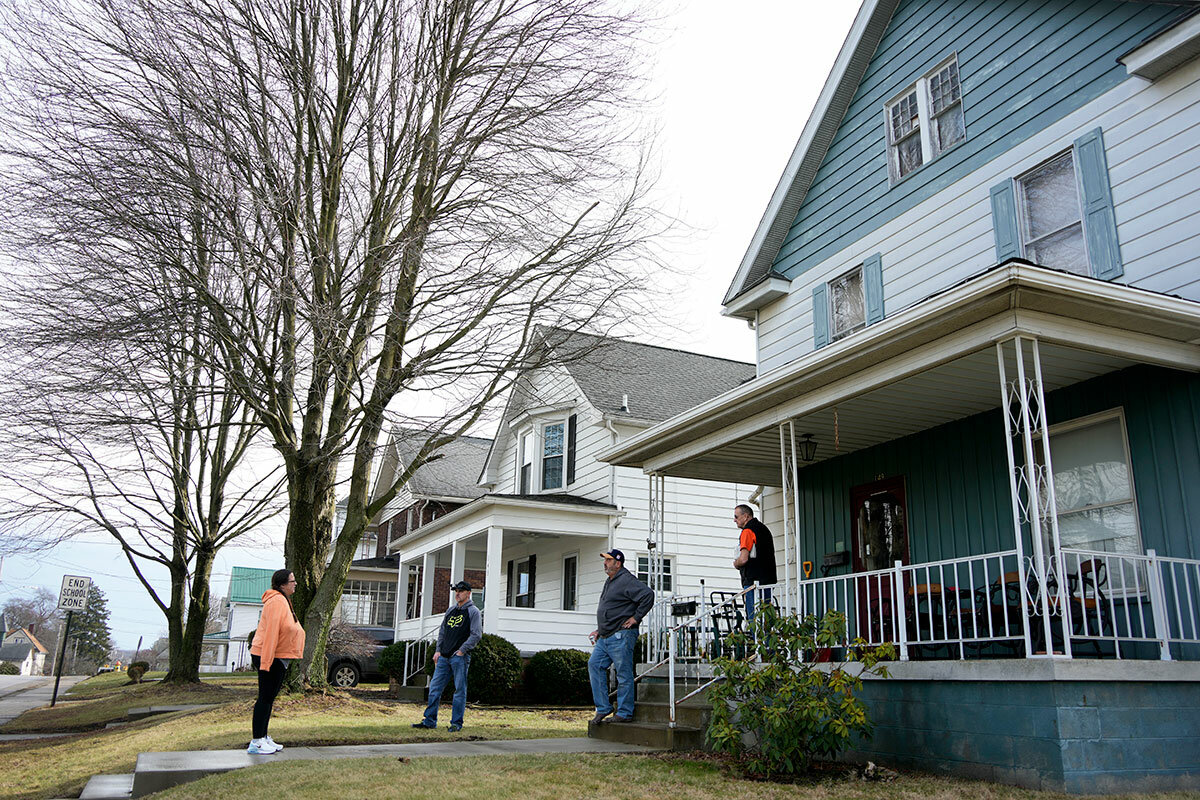‘We’re trying to protect our kids’: Ohio town seeks answers after spill
Loading...
| East Palestine, Ohio
EPA testing says the air is clean, and residents of East Palestine, Ohio, have been told they can go back home. Yet community members can still smell odors, and fish in local streams have died.
Two weeks after a train derailment caused hazardous chemicals to spill and burn in her community, Jessica Albright is among many residents seeking answers on their long-term safety.
Why We Wrote This
A story focused onAfter a train accident caused hazardous chemicals to spill and burn in their community, residents of East Palestine, Ohio, await answers on their long-term safety.
“When they released us to go back home, they didn’t give us any guidance,” she says. She heard nothing about pre-washing dishes before the next use, deep cleaning curtains, and other actions to take at home. Families “don’t know what’s the right thing to do when we’re trying to protect our kids.”
A parade of emergency responders and politicians – and yesterday the administrator of the Environmental Protection Agency – has come to the town trying to help. And today the Biden administration said a team of medical professionals would be deployed to provide health screenings.
State officials have advised residents in the region to drink bottled water. The EPA says it has screened the homes of roughly 500 residents so far and not found contaminants. The agency also pledges to hold railroad company Norfolk Southern responsible for cleanup costs.
The loud clang from the railroad tracks a few blocks from her home’s back door in East Palestine, Ohio, didn’t startle Julia Slouber. Neither did the rush of emergency vehicles just moments after. It was the knock on her door from a neighbor around 10 o’clock that Friday evening that told Ms. Slouber her hometown of the past seven years was about to change forever.
You need to leave, now, the neighbor told her.
Disoriented at the thought, Ms. Slouber stepped onto her back porch in her pajamas, where she saw the blaze burning wildly less than a mile away. She couldn’t tell how close the flames were as they lapped at the night sky, stretching above the mature maple trees in her backyard. The bright beauty of that moment stunned her; Ms. Slouber could feel the heat on her face. She then rushed to grab her three cats, her insulin, and the few belongings she could carry.
Why We Wrote This
A story focused onAfter a train accident caused hazardous chemicals to spill and burn in their community, residents of East Palestine, Ohio, await answers on their long-term safety.
“I didn’t even look back,” Ms. Slouber says, as she leans over her kitchen table.
Two weeks after a Norfolk Southern Railway freight train traveling from Pennsylvania to Illinois derailed and released tanker loads of hazardous chemicals here, a parade of emergency responders and politicians – and yesterday the administrator of the Environmental Protection Agency – has come to this small Ohio town to provide updates on the issue immediately uppermost for residents: public safety.
No one died in the accident, and officials have pledged accountability and follow-through. Yet residents like Ms. Slouber still have unanswered questions, still feel they have not been well served, and still are not sure what to do or what help will come. Their quest for security and reassurance is far from finished.
“When they released us to go back home, they didn’t give us any guidance,” says East Palestine resident Jessica Albright. She heard nothing about pre-washing dishes before the next use, deep cleaning curtains, and other actions to take at home. Families “don’t know what’s the right thing to do when we’re trying to protect our kids.”
The uncertainties span from immediate safety to the longer-term future for the town and its roughly 5,000 residents.
“I have a fixed mortgage of $216 a month,” Ms. Slouber says. “What do you do?”
The early questions were as basic as what chemicals were involved in the accident. Some 38 rail cars were involved, 11 of which carried hazardous materials that contaminated the area. Ohio officials said those rail cars were not categorized as containing hazardous chemicals, so officials were unaware of the passage of such chemicals across state lines.
On Wednesday, Norfolk Southern representatives declined to attend a community meeting in East Palestine, citing fear for their personal safety.
National attention on the incident has built slowly, heightened by news footage showing the derailment’s severity – notably the massive flames and smoke of a controlled burn-off of chemicals to avoid a possible explosion.
The National Transportation Safety Board’s investigation into the incident is ongoing. Federal investigators have said the Norfolk Southern train crew received a warning about a mechanical problem shortly before an axle failed and caused the Ohio derailment.
EPA Administrator Michael Regan visited East Palestine Thursday and pledged that “we will be here as long as it takes to ensure the health and safety of the community,” and that the government will hold Norfolk Southern responsible for the cleanup costs.
On Friday, the Biden administration announced that a team of medical personnel and toxicologists will head to the Ohio town to conduct health testing and assessments.
Tensions between industry and civilians
Two weeks removed from the train’s initial derailment, a smell of burning plastic and paint still lingers in the air. A metallic taste accompanies the fumes.
The odor no longer registers with Ms. Slouber, even if those around her can still smell it. She hasn’t ventured outside much now that she’s home, but she says her headaches have become worse.
The East Palestine spill’s fallout marks the latest tumultuous chapter in the balance between civilians and industry. For this once-peaceful rural community, questions about the future outweigh official reassurances so far.
East Palestine officials care about our health because they live here, Ms. Slouber says.
But Norfolk Southern Railway? “They don’t care,” she says.
At least five lawsuits have been filed against the railroad, which announced this week that it is creating a $1 million fund to help the community while continuing to monitor air quality and remove spilled contaminants from the ground and streams.
Evacuation order
The chemical spill’s fire burned through the weekend that followed its eruption on Friday, Feb. 3. By the next week, the combustibility of the remaining hazardous waste prompted concerns of an explosion that carried the risk of deadly shrapnel fragments ricocheting across the community.
Ms. Slouber had only returned to her home a day prior to the controlled chemical burn. She recalls an Ohio state trooper approaching her home with a warning about the planned burn.
The risks led Ohio and Pennsylvania officials to enact a mandatory evacuation for those living within about 2 miles. With limited options, and through modeling conducted by the Ohio National Guard and U.S. Department of Defense, workers poked holes in the tankers, allowing the cars’ chemical contents to drain onto the porous soil, which Norfolk Southern burned to reduce contamination.
The outcome was a massive black plume that rose from the site, but it also prevented a feared explosion.
Two days later, officials told residents that, again, it was safe to return to their homes. A statement from Ohio Gov. Mike DeWine said in-home air quality tests to date have found no presence of “contaminants of concern.”
Among those contaminants was vinyl chloride, a classified human carcinogen that is used to make PVC plastic. The EPA cites additional health risks from acute airborne exposure.
Incinerate the chemical, as officials opted to do in East Palestine, and it will break down into hydrogen chloride and phosgene, which both carry their own risks, according to the International Programme on Chemical Safety. Phosgene was once used as a weapon of war.
After the vinyl chloride burn-off, the EPA’s testing revealed the presence at the accident site of three more chemicals involved in the spill: ethylene glycol monobutyl ether, isobutylene, and ethylhexyl acrylate – the last of which is also classified as a carcinogen.
State officials have advised residents in the region to drink bottled water. The EPA says it has screened the homes of roughly 500 residents so far and not found contaminants.
Local residents in their frustration have been leaning on each other and on Mayor Trent Conaway, who is seeking answers on their behalf.
“You have to have a sense of humor about it,” Ms. Slouber says, referring to the importance of keeping her spirits up.
Lingering worries
Still, residents across the region believe the chemical spill’s harm is far from over.
The concern now, among the community and environmentalists alike, is that vinyl chloride will leach its way into the 14-state Ohio River Basin.
Prior to EPA Administrator Regan’s tour of the fallout zone on Thursday, the federal agency sent a letter Feb. 10 to Norfolk Southern Railway officials, noting that harmful substances released from the train’s derailment have been “observed and detected” entering East Palestine’s storm drains and nearby bodies of water, including the Ohio River’s tributaries.
Earlier this week, the Ohio Department of Natural Resources confirmed the mass die-off of at least 3,500 fish in waterways near the chemical spill’s site following the burn. But as the state agency’s director, Mary Mertz, noted in a press conference last week, researchers have not observed the same consistency in wildlife fatalities beyond the first few days after the initial derailment.
Michael Bosswell, a member of the East Palestine community for 30 years and Ms. Slouber’s son, recalls his trek down to some of his favorite fishing spots on the creek near his mother’s home following the chemical spill. Mr. Bosswell recalls seeing dead raccoons and other creatures lying along the forest floor, while dead fish and minnows floated in the creek.
“Everything eats fish,” Mr. Bosswell says, shaking his head. “The fox, the birds.”
Material from The Associated Press was used in this article.










